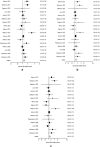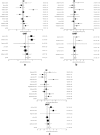Association between OGG1 Ser326Cys polymorphism and risk of upper aero-digestive tract and gastrointestinal cancers: a meta-analysis
- PMID: 27026921
- PMCID: PMC4771670
- DOI: 10.1186/s40064-016-1858-5
Association between OGG1 Ser326Cys polymorphism and risk of upper aero-digestive tract and gastrointestinal cancers: a meta-analysis
Abstract
Cancers of the upper aero-digestive and gastrointestinal tract are one of the major causes of mortality around the world. DNA repair genes play a vital role in preventing carcinogenesis by maintaining genomic integrity. Polymorphisms in the nucleotide sequence of DNA repair genes are often reported to be associated with an increased risk for different cancers. The OGG1 gene encodes the enzyme 8-oxoguanine DNA glycosylase which removes oxidatively damaged bases of DNA. Several studies report that the OGG1 Ser326Cys polymorphism increases the risk for cancers of the upper aero-digestive and gastrointestinal tract. However, other studies provide evidence that such an association does not exist. A meta-analysis to assess the role of OGG1 Ser326Cys polymorphism in the cancers of the upper aero-digestive and gastrointestinal tract was therefore undertaken in order to resolve this ambiguity. Seventeen studies were recruited for this meta-analysis after screening 58 articles with a total of 5533 cases and 6834 controls for which the odds ratio with 95 % confidence interval was calculated. Begg's funnel test and Egger's test were performed for calculating publication bias. Our study reveals an association between OGG1 Ser326Cys polymorphism and cancer susceptibility of the upper aero-digestive and gastrointestinal tract (CG + GG vs CC; odds ratio, OR 1.22; 95 % CI 1.05-1.41; GG vs CG + CC; OR 1.36; 95 % CI 1.09-1.70; GG vs CC; OR 1.46; 95 % CI 1.12-1.92). Subgroup analysis based on cancer types and ethnicity also revealed the association of OGG1 Ser326Cys polymorphism to the risk for upper aero-digestive and gastrointestinal tract cancers among both the Asian and the Caucasian populations. No risk was however observed for smoking habits and OGG1 Ser326Cys polymorphism. In conclusion, OGG1 Ser326Cys polymorphism may be associated with the increased risk for aero-digestive tract and gastro-intestinal cancers in both Asian and Caucasian populations.
Keywords: Gastrointestinal; Meta-analysis; OGG1; Upper aero-digestive tract.
Figures




Similar articles
-
Association between the OGG1 Ser326Cys and APEX1 Asp148Glu polymorphisms and lung cancer risk: a meta-analysis.Mol Biol Rep. 2012 Dec;39(12):11249-62. doi: 10.1007/s11033-012-2035-8. Epub 2012 Oct 12. Mol Biol Rep. 2012. PMID: 23065211
-
Association of OGG1 Ser326Cys polymorphism and pancreatic cancer susceptibility: evidence from a meta-analysis.Tumour Biol. 2014 Mar;35(3):2397-402. doi: 10.1007/s13277-013-1317-7. Epub 2013 Nov 3. Tumour Biol. 2014. PMID: 24186001 Free PMC article.
-
Association of hOGG1 Ser326Cys polymorphism with susceptibility to hepatocellular carcinoma.Int J Clin Exp Med. 2015 Jun 15;8(6):8977-85. eCollection 2015. Int J Clin Exp Med. 2015. PMID: 26309550 Free PMC article.
-
Could 8-oxoguanine DNA glycosylase 1 Ser326Cys polymorphism be a biomarker of susceptibility in cancer?Toxicol Ind Health. 2014 Oct;30(9):814-25. doi: 10.1177/0748233712463777. Epub 2012 Oct 18. Toxicol Ind Health. 2014. PMID: 23081862 Review.
-
The OGG1 Ser326Cys polymorphism and the risk of esophageal cancer: a meta-analysis.Genet Test Mol Biomarkers. 2013 Oct;17(10):780-5. doi: 10.1089/gtmb.2013.0224. Epub 2013 Aug 3. Genet Test Mol Biomarkers. 2013. PMID: 23909557 Review.
Cited by
-
Dual Inhibitors of 8-Oxoguanine Surveillance by OGG1 and NUDT1.ACS Chem Biol. 2019 Dec 20;14(12):2606-2615. doi: 10.1021/acschembio.9b00490. Epub 2019 Oct 29. ACS Chem Biol. 2019. PMID: 31622553 Free PMC article.
-
Potent and Selective Inhibitors of 8-Oxoguanine DNA Glycosylase.J Am Chem Soc. 2018 Feb 14;140(6):2105-2114. doi: 10.1021/jacs.7b09316. Epub 2018 Feb 5. J Am Chem Soc. 2018. PMID: 29376367 Free PMC article.
-
DNA repair genes polymorphisms and genetic susceptibility to Philadelphia-negative myeloproliferative neoplasms in a Portuguese population: The role of base excision repair genes polymorphisms.Oncol Lett. 2017 Jun;13(6):4641-4650. doi: 10.3892/ol.2017.6065. Epub 2017 Apr 21. Oncol Lett. 2017. PMID: 28599464 Free PMC article.
References
-
- Babron MC, Kazma R, Gaborieau V, McKay J, Brennan P, Sarasin A, Benhamou S. Genetic variants in DNA repair pathways and risk of upper aerodigestive tract cancers: combined analysis of data from two genome-wide association studies in European populations. Carcinogenesis. 2014;35(7):1523–1527. doi: 10.1093/carcin/bgu075. - DOI - PubMed
-
- Barnes L. Pathology and genetics of head and neck tumours. Lyon: IARC; 2005.
-
- Bhatt AN, Mathur R, Farooque A, Verma A, Dwarakanath BS. Cancer biomarkers—current perspectives. Indian J Med Res. 2010;132:129–149. - PubMed
-
- Bhowmik A, Das S, Bhattacharjee A, Choudhury B, Naiding M, Deka S, Ghosh SK, Choudhury Y. MDM2 and TP53 polymorphisms as predictive markers for head and neck cancer in Northeast Indian population: effect of gene–gene and gene–environment interactions. Asian Pac J Cancer Prev. 2015;16(14):5767–5772. doi: 10.7314/APJCP.2015.16.14.5767. - DOI - PubMed
Publication types
LinkOut - more resources
Full Text Sources
Other Literature Sources
Research Materials

